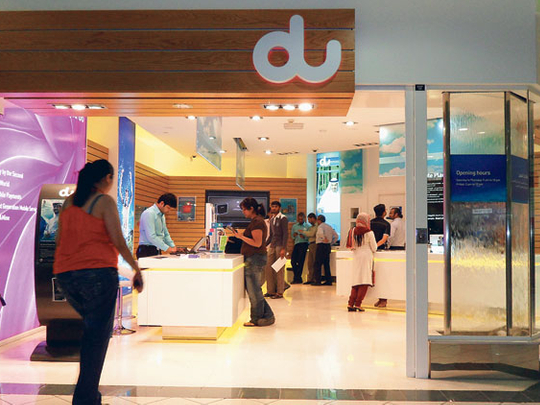
Dubai: Indian expatriate Manoj Vayan is a living, breathing example of why the UAE enjoys one of the highest per-capita concentration of mobile phones — more than 200 per cent — in the world.
While waiting outside a du retail office in Bur Dubai, Vayan, 42, clutches three mobile phones in his left hand as his wife inquires about acquiring her own second phone with du.
The Vayans have long used etisalat for their personal phones and are opting for du mobile service to take advantage of competitive new local and international rates.
The couple never dreamed they would own five active phones at one time, the fifth device serving exclusively as Manoj's business phone, a lifeline that connects him to the world as manager of chauffeur services for Emirates airline.
"It's really not that strange for Dubai," Vayan says, eyes fixed on a throng of shoppers hovering over display phones in the outlet. "Everyone I know here, it seems, has two mobile phones."
Vayan said he's thankful all three of his phones have never rang simultaneously.
Telecom analyst Zeena Bourqan, with the Jordanian research firm Arab Advisors Group, said multiple phones for every UAE household isn't surprising due to the country's love for all things technological.
"I think the reason for high penetration in the UAE is [that the country] is so technically oriented. There is nothing stopping them from getting the most advanced technology they can have," Bourqan said in an interview.
The UAE's mobile phone penetration rate is "the highest in the region. Nobody has exceeded the 200 per cent-mark", she said.
Saudi Arabia follows in second with a 165 per cent penetration rate.
The market saturation can also be attributed to major trends over the last several years that have changed the telecom landscape within the UAE, said Bourqan.
Virtual explosion
Market forces ranging from "3G technology, competition in the market in the last three years, and dropping cellular rates" have spawned a virtual explosion of accelerated mobile phone use in a very short time, she said.
The introduction of du in February 2007 as a direct competitor into a telecom market, previously served exclusively by etisalat, probably bolstered sales of phones and SIM cards across the board, she said.
"Maybe that encouraged more people to have more than one line to take advantage of more than one package offered by both operators," Bourqan observed.
It's not known if increased competition contributed to a reported first-quarter drop this year in the number of etisalat subscribers by 30,000, leading to an 8.4 per cent decline in first-quarter net profit to Dh1.99 billion.
In a statement, etisalat said that its mobile subscribers in the first quarter was 7.71 million.
Du spokespersons told Gulf News that first-quarter figures will be released soon. The operator posted a 35 per cent growth in 2009 revenues.
Du said the boost was in large part thanks to a marked jump in its mobile subscription volumes from the year before.
According to du, "1,011,200 active mobile customers [were] acquired, an increase of 41 per cent year on year", bringing its total active roster to 3,477,000.
In the last quarter of 2009 alone, du added 337,900 active subscribers.
Osman Sultan, du's Chief Executive, said in a year-end report: "Our position in the mobile market is a strong one and we have realised our ambition in a short time of becoming a serious player in the UAE."
In late January, Telecommunications Regulatory Authority Director-General Mohammad Nasser Al Ganem rolled out a new Competition Framework to prevent anti-competitive behaviour in the industry.
Guidance to stakeholders
He told reporters at TRA's Abu Dhabi headquarters that "the framework will not only ensure that TRA continues to foster growth and development of the telecommunication sector through the creation of sustainable, vibrant and fair competition, but will also give guidance to stakeholders operating in this sector as to what TRA considers as being acceptable competitive behaviour".
According to January 10, 2009 numbers obtained from the TRA, there are 10,684,870 active mobile subscriptions in the UAE.
The number, said the TRA, translates into a penetration rate of 203.7 per cent.
Of the more than 10.6 million subscriptions, 9.7 million are pre-paid accounts that depend on pay-as-you-go cards, while only 969,000 users rely on post-paid accounts, the statistics show.
The mobile figures dwarf landline counts that show there are 1.54 million fixed lines in the country for a penetration rate of 29.5 per cent.
Arab telecom sector grows
The UAE isn't the only Arab nation with a high mobile penetration rate.
Numbers released by Arab Advisors Group show that Arab cellular lines grew by 17 per cent in the first nine months of 2009.
The research firm found that 47 mobile operators in 17 Arab countries served 241.3 million subscribers at the end of 2009, an increase of 16.6 per cent over 2008.
Telecom companies that reported huge gains include MobiNil and Vodafone of Egypt and STC of Saudi Arabia.
Arab Advisors Group said that between October 2008 and December 2009, three new cellular operators and three mobile virtual network operators launched their operations in the Arab World. With the advent of new operators and increased competition, subscribers in 17 Arab countries reached 241.3 million by end of September 2009.
- 10.6m mobile phone subscriptions in UAE
- 9.7m of them are pre-paid accounts
- 969,000 are post-paid accounts












